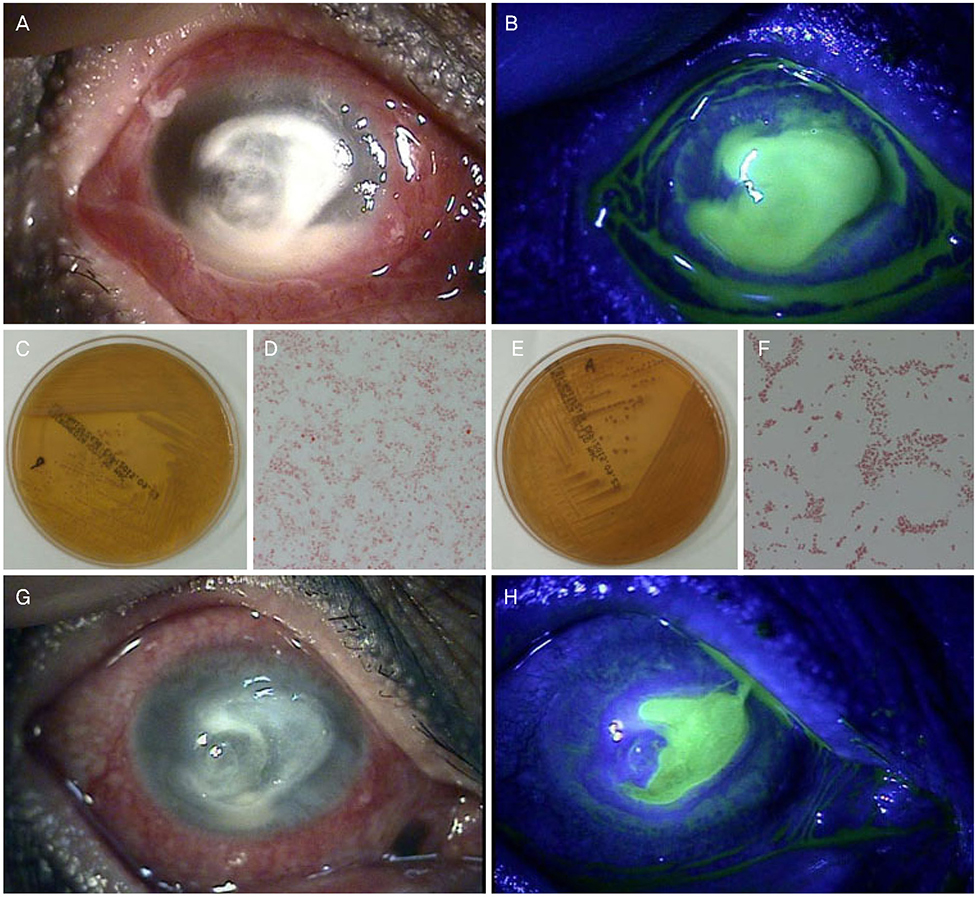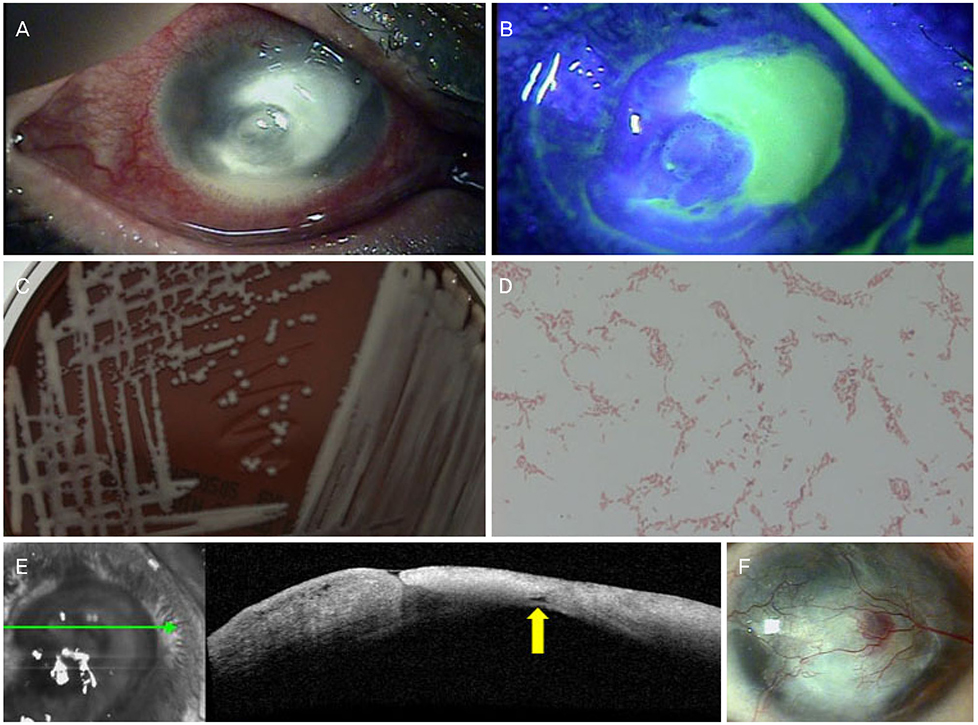J Korean Ophthalmol Soc.
2019 May;60(5):474-479. 10.3341/jkos.2019.60.5.474.
Polymicrobial Keratitis of Pseudomonas aeruginosa, Acinetobacter baumannii, and Ochrobactrum anthropi
- Affiliations
-
- 1BGN Eye Clinic, Busan, Korea.
- 2The Bom Eye Clinic, Busan, Korea.
- 3Department of Ophthalmology, Gyeongsang National University Changwon Hospital, Changwon, Korea.
- 4Department of Ophthalmology, Kosin University College of Medicine, Busan, Korea. hhiatus@gmail.com
- 5Institute for Medicine, Kosin University College of Medicine, Busan, Korea.
- KMID: 2445142
- DOI: http://doi.org/10.3341/jkos.2019.60.5.474
Abstract
- PURPOSE
To report polymicrobial keratitis involving Pseudomonas aeruginosa, Acinetobacter baumannii, and Ochrobactrum anthropi.
CASE SUMMARY
A 53-year-old female complained of pain and secretion in her right eye, which started 6 weeks before her visit. She applied steroid ointment, which was received from the dermatologist, to her eyelid 7 days prior to her visit but this treatment worsened her symptoms. At the initial visit, the visual acuity of the right eye was light perception, and purulent secretions were observed. Using a slit lamp, severe conjunctival hyperemia, hypopyon, and a ring-shaped central corneal ulcer were observed. The anterior chamber and fundus were not observed due to corneal lesions but ultrasonography showed no intraocular inflammation. Infectious keratitis was suspected and cultured by corneal scraping. During the incubation period, 0.5% moxifloxacin, 2% voriconazole, and 1% cyclopentolate were administered. A total of 400 mg of moxifloxacin and 100 mg of doxycycline were given orally. In the primary culture, Pseudomonas aeruginosa and Acinetobacter baumannii were identified so 5% ceftazidime, which was sensitive for the antibiotic susceptibility results was further instilled. Thereafter, the keratitis improved but the keratitis again worsened while maintaining the topical treatment. A secondary culture was positive for Ochrobactrum anthropi. Treatment with 1.4% gentamicin, which was sensitive for the antibiotic susceptibility test was added and the keratitis improved. A conjunctival flap was performed because of the increased risk of perforation.
CONCLUSIONS
We report polymicrobial keratitis involving Pseudomonas aeruginosa, Acinetobacter baumannii, and Ochrobactrum anthropi for the first time in the Republic of Korea.
MeSH Terms
-
Acinetobacter baumannii*
Acinetobacter*
Anterior Chamber
Ceftazidime
Corneal Ulcer
Cyclopentolate
Doxycycline
Eyelids
Female
Gentamicins
Humans
Hyperemia
Inflammation
Keratitis*
Middle Aged
Ochrobactrum anthropi*
Ochrobactrum*
Pseudomonas aeruginosa*
Pseudomonas*
Republic of Korea
Slit Lamp
Ultrasonography
Visual Acuity
Voriconazole
Ceftazidime
Cyclopentolate
Doxycycline
Gentamicins
Voriconazole
Figure
Reference
-
1. Hahn YH, Lee SJ, Tchah HW, et al. Epidemiology of Pseudomonas keratitis : a multi-center study. J Korean Ophthalmol Soc. 1999; 40:2411–2422.2. Kim ST, Lee YC, Heo J, Koh JW. A case of acinetobacter baumannii keratitis after contact lens wearing. J Korean Ophthalmol Soc. 2008; 49:1696–1700.
Article3. Shin KY, Cho KJ. Clinical features of acinetobacter baumannii keratitis. J Korean Ophthalmol Soc. 2015; 56:607–613.
Article4. Choi JK, Kim IH, Seo JW. A case of keratitis caused by combined infection of multidrug-resistant acinetobacter baumannii and candida parapsilosis. J Korean Ophthalmol Soc. 2012; 53:1167–1171.5. Venkateswaran N, Wozniak RA, Hindman HB. Ochrobactrum anthropi keratitis with focal Descemet's membrane detachment and intracorneal hypopyon. Case Rep Ophthalmol Med. 2016; 2016:4502105.6. Braun M, Jonas JB, Schönherr U, Naumann GO. Ochrobactrum anthropi endophthalmitis after uncomplicated cataract surgery. Am J Ophthalmol. 1996; 122:272–273.
Article7. Chiang CC, Tsai YY, Lin JM, Chen WL. Chronic endophthalmitis after cataract surgery secondary to Ochrobactrum anthropi. Eye (Lond). 2009; 23:1237–1238.
Article8. Kim KS, Han JW, Lee WK. A case of Ochrobactrum anthropi endophthalmitis after cataract surgery. J Korean Ophthalmol Soc. 2003; 44:1943–1947.9. Romero Gómez MP, Peinado Esteban AM, Sobrino Daza JA, et al. Prosthetic mitral valve endocarditis due to Ochrobactrum anthropi: case report. J Clin Microbiol. 2004; 42:3371–3373.10. Chain PS, Lang DM, Comerci DJ, et al. Genome of Ochrobactrum anthropi ATCC 49188 T, a versatile opportunistic pathogen and symbiont of several eukaryotic hosts. J Bacteriol. 2011; 193:4274–4275.11. Eveillard M, Kempf M, Belmonte O, et al. Reservoirs of Acinetobacter baumannii outside the hospital and potential involvement in emerging human community-acquired infections. Int J Infect Dis. 2013; 17:e802–e805.
Article12. Ruiz J, Núñez ML, Pérez J, et al. Evolution of resistance among clinical isolates of Acinetobacter over a 6-year period. Eur J Clin Microbiol Infect Dis. 1999; 18:292–295.13. Peleg AY, Paterson DL. Multidrug-resistant Acinetobacter: a threat to the antibiotic era. Intern Med J. 2006; 36:479–482.
Article14. Thoma B, Straube E, Scholz HC, et al. Identification and antimicrobial susceptibilities of Ochrobactrum spp. Int J Med Microbiol. 2009; 299:209–220.
Article
- Full Text Links
- Actions
-
Cited
- CITED
-
- Close
- Share
- Similar articles
-
- Clinical Features of Acinetobacter Baumannii Keratitis
- Susceptibility of Clinical Isolates of Acinetobacter baumannii and Pseudomonas aeruginosa to Colistin and Polymyxin B in Korea
- Prevalence of Metallo-beta-lactamases in Imipenem-non-susceptible Pseudomonas aeruginosa and Acinetobacter baumannii
- Atypical Pseudomonas Keratitis
- Antimicrobial Resistance and Clones of Acinetobacter Species and Pseudomonas aeruginosa



